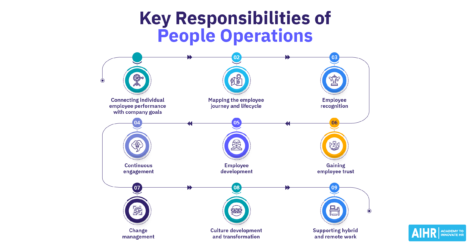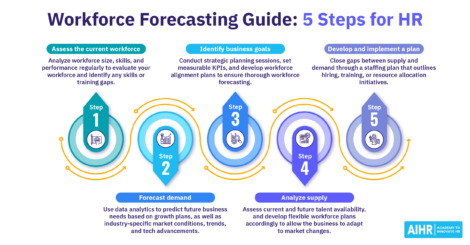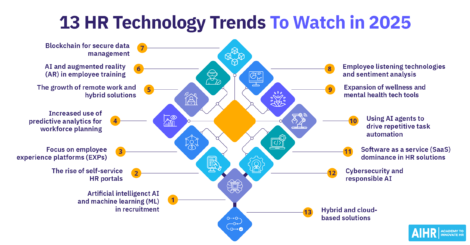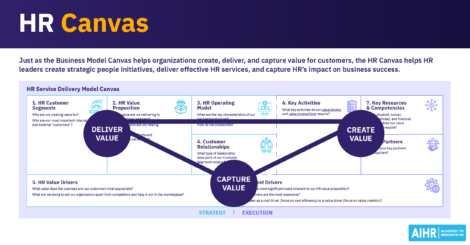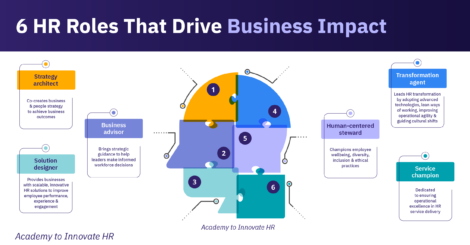The 7 Core HR Processes: Your Ultimate 2025 Guide
“Human resources isn’t a thing we do. It’s the thing that runs our business,” said American property developer Steve Wynn. So, what are these processes, and how can you optimize them to help your workforce and the business thrive?

At its heart, HR is about looking after employees by guiding them through every step of the employee journey through the core HR processes. It ensures the organization retains top talent so it can meet its short—and long-term goals.
So, what core HR processes should you focus on in your organization, and how can you maximize their efficiency?
Contents
What are HR processes?
7 core HR processes
Mapping HR processes
HR processes checklist (free template)
3 steps to streamline your HR processes
What are human resources processes?
HR processes are strategies that streamline core HR functions and support the employee life cycle. Core HR processes include recruitment, employee onboarding, training and development, performance management, compensation and benefits, employee relations, and compliance.
HR processes can improve a business’s operation, clarify its overall purpose, and help it grow. Making these processes as efficient as possible can create a positive employee experience and give the business a competitive edge.
The right HR processes can also help HR gain a seat at the leadership table where it belongs and allow it to be a strategic voice in the business.
7 core HR processes
The following HR processes and procedures matter the most for HR and organizational success.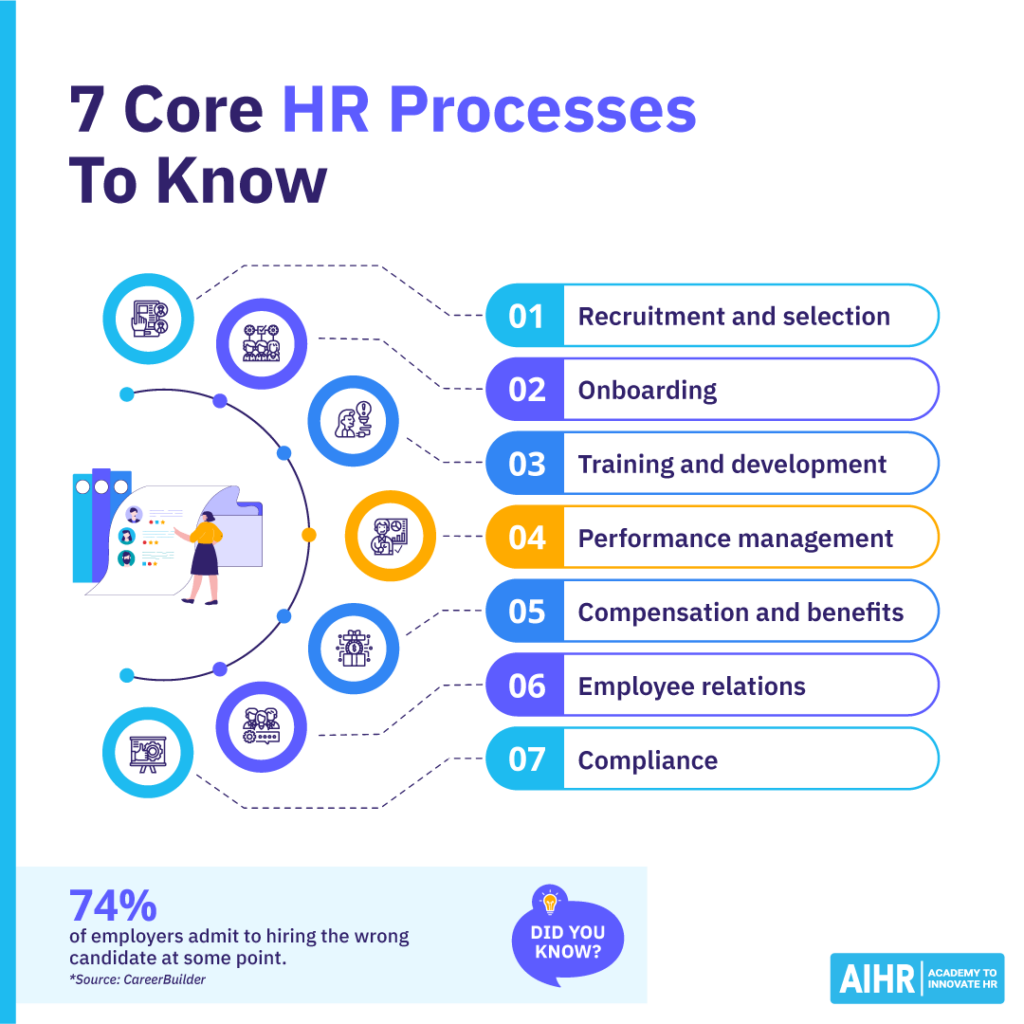
1. Recruitment and selection
To attract and hire the best candidates, you need an effective hiring process that attracts them. Statistics show that 74% of employers admit to hiring the wrong candidate at some point; this makes every stage of the recruitment process equally important.
Applicant tracking software (ATS) is a useful tool for this purpose. It will help you gather valuable information and quicken your hiring process.
HR process example: The application process
HR must liaise with hiring managers to craft accurate, compelling job descriptions. They must then post these listings on their organization’s careers page, job boards like Indeed, and social media channels like LinkedIn.
You can partner with recruitment agencies to tap into their talent pools when recruiting for hard-to-fill or specialist roles or visit universities to scope out the best talent.
Because of high drop-off rates and competition, you should make it easy for candidates to apply for jobs. Use mobile-friendly forms with important but easy to answer questions to collect candidate data.
2. Onboarding
Employee onboarding begins from the moment a candidate signs an employment contract with your company and usually ends after their first 90 days or first year as an employee. According to Gallup, only 29% of employees feel prepared for their new roles and are ready to thrive following onboarding.
HR is responsible for showing new hires around the office and answering their questions. These include queries about their roles, performance expectations, provided equipment, employee benefits, and company policies and procedures.
HR process example: First-day job orientation
HR welcomes new hires and helps them settle into the organization. In fact, many HR departments make team introductions during the pre-boarding stage, before each hire’s first official day, to foster a sense of belonging.
On a new hire’s first day, greet them at the door, give them an access card, and discuss the day’s agenda. After this, offer a tour of the office and introduce them to their team and manager.
Several businesses (such as Netflix) pair each new employee with an onboarding buddy to act as their support system. HR helps managers to develop a clear 30-60-90 day onboarding plan to set expectations.
3. Training and development
The Association for Talent Development (ATD) found that companies with a formal training program saw a 218% rise in profitability per employee and greater profit margins. The right training and development program can boost employee retention and address skills gaps to keep your organization competitive.
HR is responsible for:
- Assessing training needs
- Designing and developing training programs
- Sourcing and selecting training providers
- Organizing training logistics
- Facilitating or coordinating training delivery
- Evaluating training effectiveness
- Monitoring training compliance.
Training methods are also progressing as hybrid/remote work and rapid technological advancements become more prevalent. As an HR professional, knowing which new tools to use and how to use them can help you facilitate talent growth.
HR process example: Assessing training needs
HR assesses the workforce’s current training needs by conducting performance evaluations and analyzing skill gaps. HR also examines the organization’s goals for future growth and the knowledge, skills, and competencies employees need to get there.
Heineken, for example, created a six-month learning and development program. Business leaders partner with session facilitators to ensure the content is applicable to the organization’s context. The company designed the program with the learning strategy pillars in mind.
4. Performance management
Performance management involves managers regularly meeting with employees to set goals, assess progress, and provide feedback to help them maximize their potential.
While most businesses conduct performance reviews every six to 12 months, more are now opting for 360-degree feedback as a more holistic approach to assessing employee performance.
HR process example: Performance appraisals
HR works closely with managers to set performance criteria and benchmarks. During performance reviews, managers provide feedback on each employee’s individual performance. This includes their strengths, accomplishments, areas for improvement, and future goals.
Creating consistent performance management for employees and managers was essential for the HR team at Melbourne-based company Linktree. They knew some managers were conducting performance reviews but didn’t have insights into how often or the structure of the reviews.
HR then implemented biannual 360-degree reviews, quarterly career and growth conversations, and biweekly one-on-ones across the organization to help build consistency in the appraisal process. This, in turn, helped establish expectations on performance management for employees and managers.
5. Compensation and benefits
HR is responsible for offering and handling compensation and benefits packages. This includes managing payroll, salaries, benefits, and bonuses, which require careful management.
While job seekers take into account many other factors when considering job offers, the right compensation package is still essential to attracting and retaining top talent.
HR process example: Creating a compensation and benefits package
Different people prioritize different benefits — as an HR professional, you should learn what each shortlisted candidate wants and how to offer it to them. Job seekers tend to be more concerned about their total compensation package rather than compensation alone.
Perks like health insurance, PTO, pension plans, and even pet insurance have become increasingly important. For example, a Harvard Business Review survey found that 88% of its respondents consider private health insurance a key factor when contemplating job offers.
Netflix, for instance, offers its employees tailored compensation packages to suit their individual preferences. This includes a unique vacation policy, competitive stock options, and 4% salary match on their 401(k) program.
6. Employee relations
Employee relations involve HR addressing concerns, managing conflict, and fostering a positive work environment. This includes managing workplace culture, ensuring employee health and safety, and supporting work-life balance, which helps reduce turnover.
HR process example: Conflict resolution
HR is the go-to department for reporting and handling workplace conflict. For instance, if an employee raises a complaint about bullying by a manager, it is your responsibility to record and file a formal report and thoroughly investigate the claim.
It’s HR’s responsibility to then resolve it as quickly, calmly, and objectively as possible. If you encounter any behavior that violates the workplace’s code of conduct, it’s essential to handle it swiftly and appropriately.
7. Compliance
HR must ensure the organization abides by all relevant labor laws and regulations. These vary depending on industry, location, and the type of work carried out.
As part of your company’s HR team, you would be involved in developing and implementing procedures to ensure the business is legally compliant at all times to avoid severe penalties.
HR process example: Statutory compliance in different jurisdictions
Statutory compliance in a single region is one thing. When an organization operates in multiple jurisdictions, HR must ensure that the business remains compliant across multiple locations.
- Employment laws: Different regions have varying laws regarding hiring, termination, working hours, and employee rights. HR must ensure that contracts and practices comply with local laws.
- Tax regulations: Payroll taxes, social security contributions, and other tax obligations can differ significantly. HR needs to manage these to avoid legal issues.
- Health and safety standards: Compliance with occupational health and safety regulations within each jurisdiction is crucial to protect employees and avoid penalties.
- Data protection and privacy: With laws like GDPR in Europe, HR must ensure that employee data is handled according to local privacy regulations.
- Labor relations: Understanding the role of unions and collective bargaining agreements in different regions is essential for maintaining good labor relations.
Mapping human resources processes
What is mapping HR processes?
Mapping HR processes entails visualizing the steps involved in HR functions, including roles, responsibilities, interactions, and workflows. This visual blueprint or map aims to help you identify inefficiencies and areas for improvement within your HR department.
This clear visual reference can improve communication and collaboration amongst team members and ensure compliance by documenting operating procedures.
HR tip
Interviews, surveys, and reports are all goldmines of data that will help you analyze your current HR processes, address issues and potential concerns, and identify areas for improvement.
How to create an HR process map
- Set goals: The first step is to know what you want to achieve and how you define success. For instance, which specific HR processes should you map, and which metrics must you track? Remember to align your goals with the organization’s wider objectives.
- Gather data: Next, collect the data you need to map your HR processes. It’s important to collect a range of data covering each process’s full breadth.
- Create your map: With this data, you can begin mapping. Select a tool or software and follow a standard format. Create an overview of each core HR process, then dig deeper into the smaller processes, actions, and responsibilities within each one.
- Optimize your HR processes: You can now analyze your existing HR processes. How can you be more efficient, implement automation, and increase value? Make a list of opportunities for improvement, write down the steps involved, and prioritize them.
- Implement changes: Now, you can implement the proposed changes. A detailed action plan, along with specific tasks, people involved, required resources, and delivery dates, will help everyone stay on track.
- Monitor progress: The final step is to monitor the effect of the changes to your HR processes. The metrics you set at the start will help you measure your success. If something hasn’t worked, now is the time to determine why and make adjustments. Don’t forget to share what has worked and celebrate it.
HR processes checklist (free template)
Once you’ve mapped out your human resources processes, create an HR process checklist to ensure you don’t leave out anything. Give your HR colleagues access to this checklist so they are on the same page and can step in whenever any team member is unavailable.
This checklist also helps non-HR staff understand what happens in HR. For example, hiring managers can see the length of their current onboarding process and understand why new hires cannot immediately begin work.
Finally, an HR processes checklist helps you stay compliant when submitting forms on time, preparing for audits, and staying updated on changes to employment laws.
Here is an example of a new hire onboarding checklist (plus a free template you can download and use).
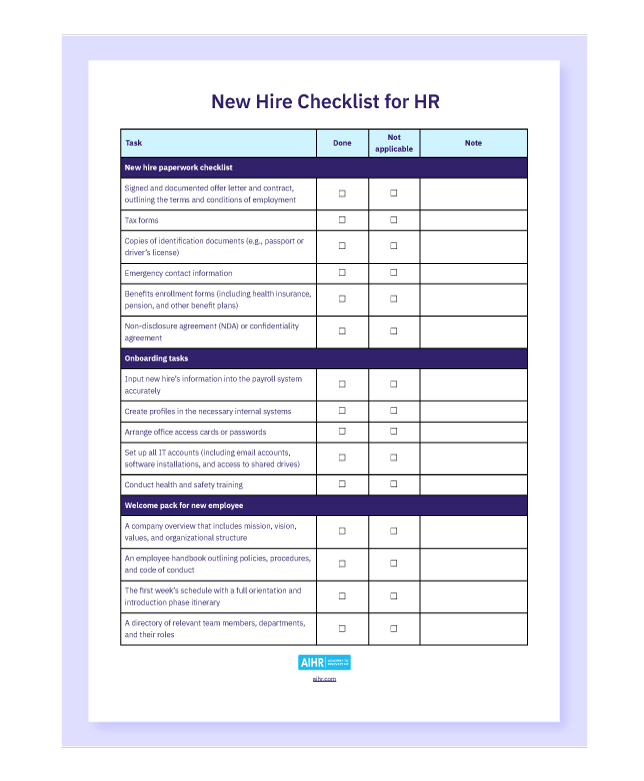
HR tip
An HRMS (human resource management system) or HRIS (human resource information system) can help process and store employee data, and automate core HR processes.
3 steps to streamline your HR processes
Here are three simple steps to take to streamline HR processes and increase efficiency.
1. Automate HR processes
Eliminate paper processes and repetitive manual tasks, which free up time that could be better spent on human-centered tasks that drive real value. HR software can automate tasks, including data entry, report generation, and document management.
For example, the right software can automatically remind managers to enter performance data on their employees throughout the year, ensuring they regularly track employee performance without HR having to pester them.
2. Use AI in HR
92% of Fortune 500 companies use generative AI (GenAI) in their workflows. For example, you can use ChatGPT to write compelling job descriptions, automatically send important documents to candidates and new hires, and predict employee turnover.
Chatbots and virtual assistants also empower your employees to handle their own administrative tasks (e.g., applying for leave and viewing compensation history) whenever they please. They also provide instant responses, so employees don’t need to wait for anyone from HR to email them back.
3. Use data analytics in HR
Collecting and analyzing data to uncover key trends and patterns can help HR make stronger, evidence-based decisions, boost productivity, and reduce costs. For instance, predictive analytics can forecast hiring needs, while sentiment analysis can gauge employee satisfaction.
Additionally, data-driven insights can optimize workforce planning, reduce turnover, and enhance employee engagement by tailoring programs to meet workforce needs, leading to more effective and agile HR operations.
HR tip
Google has used predictive analytics to reduce 15 to 25 rounds of interviews and testing to just four, shortening its hiring journey and reducing overall costs associated with sourcing, recruitment, and hiring.
To sum up
Streamlining HR processes is essential to enhancing organizational efficiency, reducing costs, and improving employee experience. By automating routine tasks such as payroll processing, benefits administration, and onboarding, HR can significantly reduce time-consuming manual work and minimize the risk of human error.
Also, streamlined HR processes facilitate faster response times and more transparent communication. Simplified procedures for performance reviews and employee feedback lead to greater engagement and satisfaction. This, in turn, results in better employee motivation and satisfaction and improved alignment between individual and organizational goals.
Learn more
Related articles
Are you ready for the future of HR?
Learn modern and relevant HR skills, online







